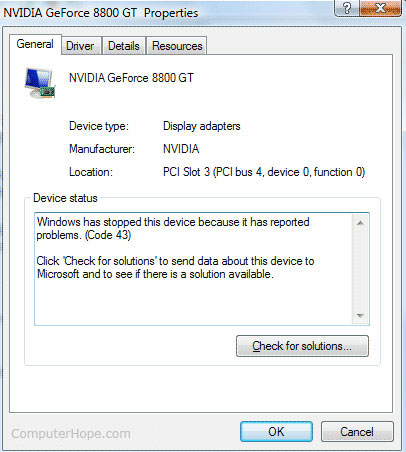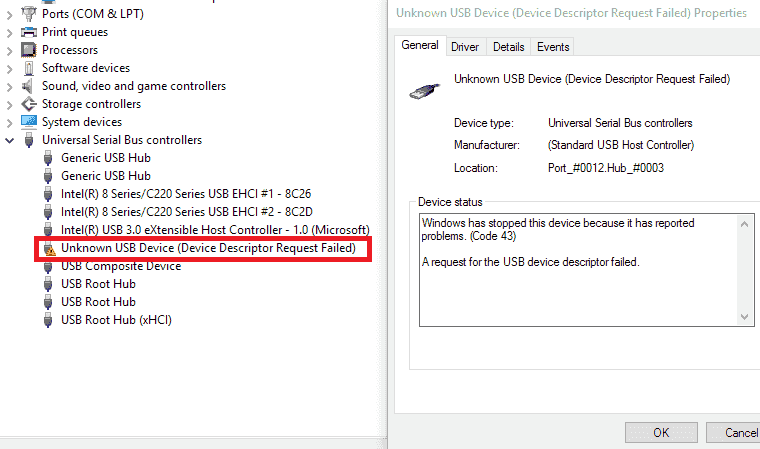Unknown Usb Device Driver Error Windows 10
- Unknown Usb Device (device Descriptor Request Failed) Driver Error Windows 10
- How To Fix Driver Errors
- Fix Driver Errors In Windows10
- Fix Driver Error Usb Drive
In case you are experiencing USB Device Not Recognized Error, whenever you plug in a USB mouse or Keyboard, you can make use of the following methods to Fix USB Device Not Recognized error in Windows 10.
Disconnect USB Devices and Restart. Disconnect all USB devices and then Restart your computer. Uninstall Faulty Device Driver. Right-click on Start button and then click on Device Manager. On the Device Manager screen, expand the entry for Universal Serial Bus Controllers right-click on the Unknown Device and click on Uninstall Device option. On the confirmation pop-up, click on OK to confirm. This is how you can solve USB Device Not Recognized on Windows 10, 7, 8, 8.1, XP 32-bit, or 64-bit operating system. If you face any difficulty while going through the process then kindly comment below. Uninstall Unknown USB device Most of the Device problem occurs due to the installed device driver and USB device not recognized may also occur due to a corrupt incompatible installed USB driver. So first update or reinstall the USB driver. Open RUN (Windows Logo + R) and type “ devmgmt.msc ” and click OK.
USB Device Not Recognized Error in Windows 10
USB Device not recognized error in Windows 10 is not only noticed while connecting new USB devices, it is also noticed in case of USB devices like your Mouse or Keyboard that are already plugged into the computer.
Irrespective of the case, you should be able to fix USB Device not recognized error in Windows 10 by using one of the following methods.
- Disconnect USB Devices and Restart
- Unplug Computer From Power Cable
- Update Device Drivers
- Check For Updates
- Disable USB Selective Suspend Setting
- Change Power Management Settings
- Uninstall Faulty Device Drivers
Make sure that you do not skip the first and the second methods as listed below.
1. Disconnect USB Devices and Restart
Disconnect all USB devices and then Restart your computer.
Once the computer restarts, plug back the USB device into the same USB port which was not recognizing it. If this does not work, try connecting the device to other USB ports on your computer.
2. Unplug Computer From Power Source
The reason for USB device not recognized error in Windows 10 could be due to your computer going through minor software glitches.
To clear this, simply Power OFF your computer and also unplug it from the power source. Wait for 5 minutes and Restart your computer.

Sometimes, this simple step can fix USB device not recognized error on your computer.
3. Update Device Drivers
Your Windows computer should automatically update the firmware for all device drivers. However, this may not always happen, resulting in device drivers becoming outdated.
1. Right-Click on the Start button and click on Device Manager option.
2. On the device Manager Screen, expand the entry for Universal Serial Bus Controllers.
3. In the expanded Universal Serial Bus Controllers, right-click on the Unknown device and click on Properties.
4. On the next screen, go to Driver tab and click on Update Driver button.
5. On the next screen, click on Search Automatically for updated driver software option.
After installing updated driver, see if your computer is able to recognize the USB device.
4. Check For Updates
See if an Update is available for your computer. If an update is available, Windows will also install the latest available drivers for your computer.
1. Click on the Start button > Settings Icon > Updates & Security.
2. On the Update and Security screen, click on Windows Update in the side menu and click on Check For Updates button.
3. Allow Windows to check for available updates and install them onto your computer
In case updates are available, the latest available device drivers will also be installed on your computer.
5. Disable USB Selective Suspend Setting
By default, Windows computer is set to conserve power by suspending power supply to external USB devices, whenever they are inactive.
However, this power saving setting can sometimes cause problems like Error Code 43 and USB Device Not Recognized Error in Windows 10.
Unknown Usb Device (device Descriptor Request Failed) Driver Error Windows 10
1. Open Control Panel on your computer.
2. On the Control Panel Screen, make sure that you are in “Category” view and click on System and Security.
3. On the System and Security Screen, click on Power Options.
4. On Power Options screen, click on Change Plan Settings link located next to the current Power Plan.
5. Next, click on Change Advanced Power Settings link.
6. On the next screen, click on USB Settings > USB selective suspend setting and select disabled option for “Plugged In” and also for “On Battery” in case you are using a Laptop.
7. Click on OK to save above settings.
6. Change Power Management Setting For USB Root Hub
1. Right-Click on Start button and then click on Device Manager option.
2. On the device Manager Screen, expand the entry for Universal Serial Bus Controllers.
3. Right-click on USB Root Hub and click on Properties.
4. On the Properties screen, click on Power Management tab and uncheck the option for “Allow the computer to turn off this device to save power” and click on OK.
In case you have more USB Root Hubs, you will need to repeat the above steps for them as well.
Note: You can recheck “Allow the computer to turn off this device to save power” option, in case this step has not helped in fixing USB device not recognized error on your computer.
7. Uninstall Faulty Device Drivers
The problem of USB device not recognized error in Windows 10 could be due to faulty, corrupted or missing device drivers.
This can be fixed by uninstalling faulty device drivers and allowing Windows to automatically reinstall them back on your computer.
Note: On rare occasions Windows may not install Device Drivers and you may end up with no USB Ports working.
1. Right-click on Start button and then click on Device Manager.
2. On the Device Manager screen, expand the entry for Universal Serial Bus Controllers.
3. In the expanded Universal Serial Bus Controllers, right-click on the faulty device and then click on the Properties option.
4. On the next screen, click on the Driver tab and then click on the Uninstall button.
5. On the pop-up, click on OK to confirm that you do want to Uninstall the driver.

6. Repeat the above steps for other affected devices
7. After all the affected devices are uninstalled, Restart your computer.
Once your computer restarts, Windows should automatically load the right drivers as required for your computer.
If your computer doesn't recognize your connected device, you might see an unknown error or a '0xE' error. If you do, follow these steps and try to connect your device again after each step:
- Make sure that your iOS or iPadOS device is unlocked and on the Home screen.
- Check that you have the latest software on your Mac or Windows PC. If you're using iTunes, make sure you have the latest version.
- Make sure that your device is turned on.
- If you see a Trust this Computer alert, unlock your device and tap Trust.
- Unplug all USB accessories from your computer except for your device. Try each USB port to see if one works. Then try a different Apple USB cable.*
- Restart your computer.
- Restart your device:
- Try connecting your device to another computer. If you have the same issue on another computer, contact Apple Support.
For more help, follow the steps below for your Mac or Windows PC.
* Learn how to connect iPad Pro (11-inch) or iPad Pro 12.9-inch (3rd generation) to your computer.
If you use a Mac
- Connect your iOS or iPadOS device and make sure that it's unlocked and on the Home screen.
- On your Mac, hold down the Option key, click the Apple menu, and choose System Information or System Report.
- From the list on the left, select USB.
- If you see your iPhone, iPad, or iPod under USB Device Tree, get the latest macOS or install the latest updates. If you don't see your device or still need help, contact Apple Support.
If you use a Windows PC
The steps differ depending on if you downloaded iTunes from the Microsoft Store or from Apple.
If you downloaded iTunes from the Microsoft Store
Follow these steps to reinstall the Apple Mobile Device USB driver:
- Disconnect your device from your computer.
- Unlock your iOS or iPadOS device and go to the Home screen. Then reconnect your device. If iTunes opens, close it.
- Click and hold (or right-click) the Start button, then choose Device Manager.
- Locate and expand the Portable Devices section.
- Look for your connected device (such as Apple iPhone), then right-click on the device name and choose Update driver.
- Select 'Search automatically for updated driver software.'
- After the software installs, go to Settings > Update & Security > Windows Update and verify that no other updates are available.
- Open iTunes.

If you downloaded iTunes from Apple
Follow these steps to reinstall the Apple Mobile Device USB driver:
How To Fix Driver Errors
- Disconnect your device from your computer.
- Unlock your iOS or iPadOS device and go to the Home screen. Then reconnect your device. If iTunes opens, close it.
- Press the Windows and R key on your keyboard to open the Run command.
- In the Run window, enter:
%ProgramFiles%Common FilesAppleMobile Device SupportDrivers - Click OK.
- Right-click on the
usbaapl64.inforusbaapl.inffile and choose Install.
You might see other files that start withusbaapl64orusbaapl. Make sure to install the file that ends in .inf. If you’re not sure which file to install, right-click a blank area in the File Explorer Window, click View, then click Details to find the correct file type. You want to install the Setup Information file. - Disconnect your device from your computer, then restart your computer.
- Reconnect your device and open iTunes.
If your device still isn't recognized
Check Device Manager to see if the Apple Mobile Device USB driver is installed. Follow these steps to open Device Manager:

- Press the Windows and R key on your keyboard to open the Run command.
- In the Run window, enter
devmgmt.msc, then click OK. Device Manager should open. - Locate and expand the Universal Serial Bus controllers section.
- Look for the Apple Mobile Device USB driver.
If you don't see the Apple Mobile Device USB Driver or you see Unknown Device:
- Connect your device to your computer with a different USB cable.
- Connect your device to a different computer. If you have the same issue on another computer, contact Apple Support.
If you see the Apple Mobile Device USB driver with an error symbol:

Fix Driver Errors In Windows10
If you see , , or next to the Apple Mobile Device USB driver, follow these steps:
Fix Driver Error Usb Drive
- Restart the Apple Mobile Device Service.
- Check for and resolve issues with third-party security software, then restart your computer.
- Try to install the
usbaapl64.inforusbaapl.inffile again.